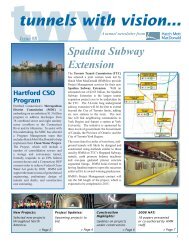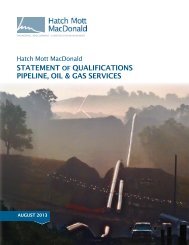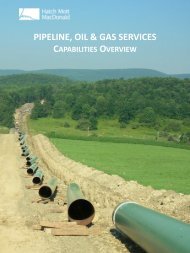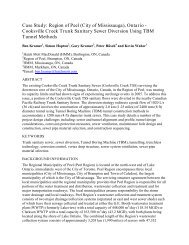statement of qualifications pipeline, oil and gas services - Hatch Mott ...
statement of qualifications pipeline, oil and gas services - Hatch Mott ...
statement of qualifications pipeline, oil and gas services - Hatch Mott ...
You also want an ePaper? Increase the reach of your titles
YUMPU automatically turns print PDFs into web optimized ePapers that Google loves.
Chemung River Crossing HDD Project<br />
Location<br />
Corning, NY<br />
Client<br />
National Fuel Gas<br />
Project Type<br />
Natural Gas Pipeline / HDD<br />
Installation<br />
Services<br />
Design Services <strong>and</strong><br />
Construction Monitoring <strong>of</strong><br />
Horizontal Directional<br />
Drilling Installation<br />
Duration<br />
Dec 2009 to Oct 2011<br />
HDD Contractor<br />
Michaels Directional<br />
Crossings<br />
817 W. Main Street<br />
PO Box 128<br />
Brownsville, WI 53006<br />
(920) 924-4300<br />
Project Description<br />
National Fuel Gas completed construction <strong>of</strong><br />
an extension <strong>of</strong> a natural <strong>gas</strong> <strong>pipeline</strong> through<br />
the Corning New York area. The project<br />
consisted <strong>of</strong> constructing a new 2,600-foot<br />
long, 24-inch diameter natural <strong>gas</strong> <strong>pipeline</strong><br />
beneath the Chemung River, Interstate 86, <strong>and</strong><br />
a major railroad in Corning, New York.<br />
The geotechnical materials consisted <strong>of</strong> 100<br />
feet <strong>of</strong> coarse grained s<strong>oil</strong> overlying shale<br />
bedrock. The s<strong>oil</strong> consisted <strong>of</strong> extensive<br />
deposits <strong>of</strong> s<strong>and</strong>s containing a high percentage<br />
<strong>of</strong> gravels, cobbles, <strong>and</strong> boulders extending<br />
from the ground surface to bedrock. Risk mitigation measures were developed to deal with the<br />
gravel, cobbles, <strong>and</strong> boulders, as these materials are not typically conducive to horizontal directional<br />
drilling (HDD) construction methods. A risk workshop was completed with the client to assess all<br />
hazards, impacts <strong>and</strong> risk control measures. Starter/conductor casings were installed on each end <strong>of</strong><br />
the alignment to bridge <strong>and</strong> support the coarse grained s<strong>oil</strong>s. On the south side <strong>of</strong> the crossing, a<br />
telescoping casing design was required to<br />
protect a heavily used public road. The<br />
casing strategy at this side <strong>of</strong> the crossing<br />
consisted <strong>of</strong> a60-inch steel casing pipe<br />
driven from the HDD exit location through<br />
to the north side <strong>of</strong> the public road. Next,<br />
direct pipe methods were employed to<br />
install 42-inch casing down <strong>and</strong> into the<br />
shale bedrock. The direct pipe method<br />
involved pushing a steerable microtunnel<br />
machine through the ground using a<br />
hydraulic thruster located at the surface.<br />
The microtunnel machine placed at the front<br />
<strong>of</strong> the casing pipe was used to excavate the<br />
coarse grained s<strong>oil</strong>s <strong>and</strong> install the casing<br />
pipe on the design line <strong>and</strong> grade. Pneumatic tools were used to advance the casing pipe on the north<br />
side <strong>of</strong> the crossing. Once the casing pipes were installed, drill <strong>and</strong> intersect methods were used to<br />
complete the pilot bore phase <strong>of</strong> the installation process. Upon completion <strong>of</strong> the HDD installation<br />
process, all <strong>of</strong> the temporary casing pipes installed at the HDD entry <strong>and</strong> exit sides were removed.<br />
HMM Role<br />
<strong>Hatch</strong> <strong>Mott</strong> MacDonald (HMM) was retained to<br />
complete the feasibility study, geotechnical<br />
investigations, full design <strong>services</strong> including<br />
preparation <strong>of</strong> bid documents, <strong>and</strong> construction<br />
administration <strong>services</strong>. A detailed risk register<br />
was developed as part <strong>of</strong> the feasibility <strong>and</strong><br />
design process to assess the site <strong>and</strong> construction<br />
method specific risks for the project. Mitigation<br />
measures were developed <strong>and</strong> incorporated into<br />
the design to address these risks.<br />
Project Highlights<br />
• 2,600-foot long, 24-inch diameter steel natural <strong>gas</strong> <strong>pipeline</strong> installed in shale.<br />
• Installation <strong>and</strong> removal <strong>of</strong> 460-feet long temporary conductor casings on each end <strong>of</strong> the bore.<br />
• Drill <strong>and</strong> intersect methods used to drill through casing <strong>pipeline</strong>s on each end <strong>of</strong> the alignment.<br />
• Direct pipe installation with microtunneling machine used to install critical southern casing.



![Tunnels With Vision, Issue 10 [PDF] - Hatch Mott MacDonald](https://img.yumpu.com/51223665/1/190x242/tunnels-with-vision-issue-10-pdf-hatch-mott-macdonald.jpg?quality=85)






